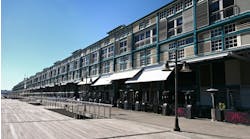In the building sector, the hot color this year is green. But, green's popularity isn't coming from flashy interior designers or brazen Paris decorators. Green technology, green buildings, and green products have entered the thoughts, lexicons, and practices of business professionals worldwide. Industry leaders in construction, manufacturing, design, etc. are turning to green practices because they're good for business. Even last year's Nobel Peace Prize was granted to individuals working to make peace between industrial advancement and the health of the planet and its people.
The phrase "green building" can mean lots of different things, but everyone agrees on some basic principles. According to the California Environmental Protection Agency (Cal/EPA), green facilities "are designed to meet certain objectives, such as protecting occupant health; improving employee productivity; using energy, water, and other resources more efficiently; and reducing the overall impact [on] the environment." Being green is more than just a practice, however; it's a process, a culture, and a belief system. According to respected entrepreneurial publication StartupNation, " 'Green,' ‘environmental,' and ‘sustainable' are more than just labels. They're practices that include every aspect of business: invention, definition, construction, production, and the ultimate disposal of the product."
The building/construction industry is no stranger to green practices; with more and more companies and consumers viewing business and purchasing decisions through green-colored glasses, the green trend continues to grow exponentially. Respondents to a January 2007 survey, conducted by Green Builder Media and Baltimore-based Imre Communications, were from across the United States and included representatives from the affordable, market rate, luxury/semi-custom, custom, multi-family, and developer categories.
Similarly, engaged members of the commercial sector are making an increasing number of business choices based on green standards. The greatest impact that green building can have in the commercial arena is on a company's most valuable resource: its people. Green business practices contribute to healthier facilities and a healthier workforce. Healthier workspaces can reduce environment-related illnesses by applying a number of commonly used green-building methods, including increased ventilation, reduced air recirculation, improved air filtration, ultraviolet disinfection of air, reduced office sharing, and reduced occupant density. According to a 2000 study by William J. Fisk (Lawrence Berkeley National Laboratory, Berkeley, CA), such improvements significantly lower the occurrence of four of the most common respiratory illnesses (rhinovirus infections, influenza, adenovirus infections, and measles), which account for 176 million days of lost work each year. Such improvements in building design can also create a 9- to 20-percent reduction in cases of the common cold, translating to 16 to 37 million fewer cases annually. Further, improved health generally increases worker performance and productivity, which translates into cost savings and improved service levels.
With the importance of green building and buying practices continuing to rise, it's hard to understand why any business or consumer would be hesitant about going green. An investment in commercial green practices is ultimately returned in the long run through the continued health of occupants and the improved productivity of workers.
In the near future, with more and more people reaping the benefits of choosing to go green, those that resist the green movement will face staunch criticism and, for businesses, potential failure. Green practices have become a fact of life in nearly every sector, and green building is only growing as a national trend. Builders, developers, corporate leaders, and small business owners all look great in green - and green isn't going out of fashion anytime soon.
Scott H. Lawson is a certified industrial hygienist and president at Concord, NH-based The Scott Lawson Group Ltd. He can be reached at (603) 228-3610 or ([email protected]).

